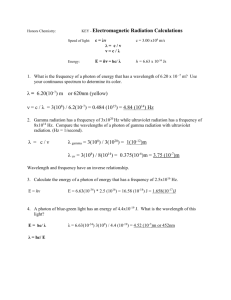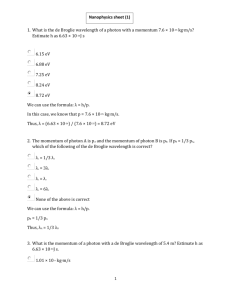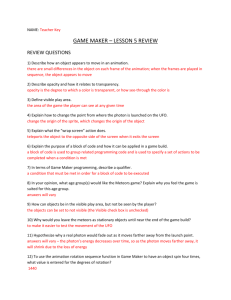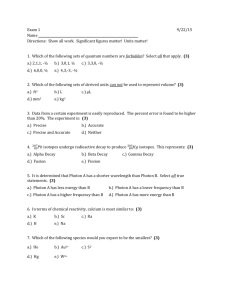Astronomy Assignment #1
advertisement
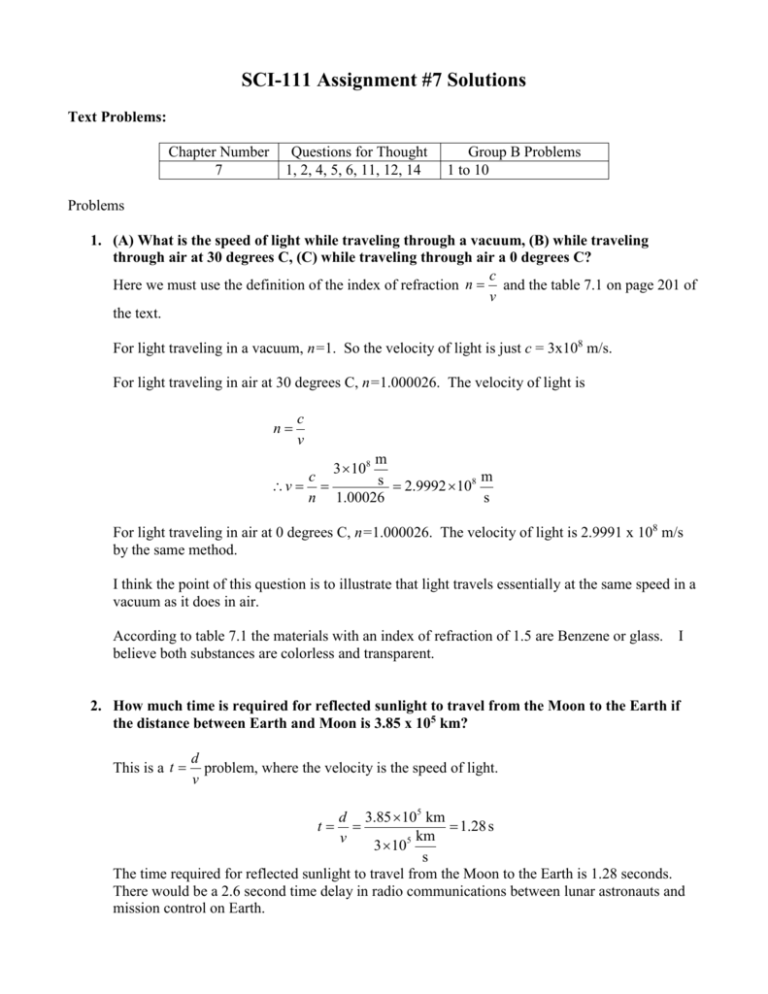
SCI-111 Assignment #7 Solutions Text Problems: Chapter Number 7 Questions for Thought 1, 2, 4, 5, 6, 11, 12, 14 Group B Problems 1 to 10 Problems 1. (A) What is the speed of light while traveling through a vacuum, (B) while traveling through air at 30 degrees C, (C) while traveling through air a 0 degrees C? c Here we must use the definition of the index of refraction n and the table 7.1 on page 201 of v the text. For light traveling in a vacuum, n=1. So the velocity of light is just c = 3x108 m/s. For light traveling in air at 30 degrees C, n=1.000026. The velocity of light is n c v m 3 108 c s 2.9992 108 m v n 1.00026 s For light traveling in air at 0 degrees C, n=1.000026. The velocity of light is 2.9991 x 108 m/s by the same method. I think the point of this question is to illustrate that light travels essentially at the same speed in a vacuum as it does in air. According to table 7.1 the materials with an index of refraction of 1.5 are Benzene or glass. believe both substances are colorless and transparent. I 2. How much time is required for reflected sunlight to travel from the Moon to the Earth if the distance between Earth and Moon is 3.85 x 105 km? This is a t d problem, where the velocity is the speed of light. v d 3.85 105 km 1.28 s v 5 km 3 10 s The time required for reflected sunlight to travel from the Moon to the Earth is 1.28 seconds. There would be a 2.6 second time delay in radio communications between lunar astronauts and mission control on Earth. t 3. How many minutes are required for a radio signal to travel from Earth to a space station on Mars if the planet Mars is 7.83 x 107 km from Earth? This is a t d problem, where the velocity is the speed of light. v d 7.83 107 km 261 s 4.35 minutes v 5 km 3 10 s A radio signal traveling from Earth to a space station on Mars, if the planet Mars is 7.83 x 107 km from Earth, would require 4.35 minutes one-way travel time. t 4. An incident light ray strikes a mirror with an angle of 30 degrees to the surface of the mirror. What is the angle of the reflected ray? The law or reflection states that the angle of incidence equals the angle of reflection. Thus the reflected angle would also be 30 degrees to the surface of the mirror. 5. The speed of light through a transparent substance is 2.00 x 108 m/s. What is the substance? c Here we must use the definition of the index of refraction n and the table 7.1 on page 201 of v the text. m c s 1.5 n v 2.00 108 m s 3 108 According to table 7.1 the materials with an index of refraction of 1.5 are Benzene or glass. believe both substances are colorless and transparent. I 6. A monochromatic light source used in a diffraction experiment has a wavelength of 4.60 x 10-7 m. What is the energy of a photon of this light? This problem is a straight forward application of the photon energy relation E=h∙f combined with the wave velocity equation c=λ∙f. 6.62 10 m J s 3 108 s c hc E h f h 4.32 1019 J 7 4 . 60 10 m The energy of a photon of this light is 4.32 x 10-19 Joules. 34 7. In black and white photography, a photon energy of about 4.00 x 10-19 J is needed to bring about the changes in the silver compounds used in the film. Explain why a red light used in a darkroom does not affect the film during developing. This problem is a straight forward application of the photon energy relation E=h∙f. Red light according to Figure 7.3 on page 195 of the text identifies red light as having a frequency of 4.3 x 1014 Hertz. This red photon will have an energy of E = h∙f = (6.62 x 10-34 J-s) ∙ (4.3 x 1014 Hz) = 2.87 x 10-19 Joules This energy is less than the 4.00 x 10-19 J needed to bring about the changes in the silver compounds used in the film. Thus, red light, no matter what its intensity, will not have enough energy to affect the film while it is exposed in the darkroom during developing. 8. The wavelength of light from a monochromatic source is measured to be 6.80 x 10-7 m. a. What it the frequency of this light? This problem is a straight forward application of the the wave velocity equation c=λ∙f. Solve for frequency c f f c 3 108 m s 7 6.80 10 m 4.41 1014 Hz The photon would have a frequency of 4.41 x 1014 Hertz. b. What color would you observe? The boundaries of visible light are 400 nm (4 x 10-7 m) for Blue and 700 nm (7 x 10-7 m) for red light. The photon in the question with wavelength 680 nm (6.80 x 10-7 m) is clearly much closer to red than blue. The photon would look quite red, perhaps orange. This is supported by figure 7.3 on page 195 in the text that illustrates the visible spectrum with its frequency limits. Our photon with frequency of 4.41 x 1014 Hertz, is very close to that of red light at 4.3 x 1014 Hertz. 9. How much greater is the energy of a photon of ultraviolet radiation (λ=3.00 x 10-7 m) that the energy of an average photon of sunlight (λ=5.60 x 10-7 m)? This problem is a straight forward application of the photon energy relation E=h∙f combined with the wave velocity equation c=λ∙f. For the UV photon EUV h f UV , and for the average sunlight photon ESun h fSun , Taking their ratio yields EUV h f UV f UV ESun h fSun fSun c UV c Sun Sun 5.60 107 m 1.87 c UV c UV 3.00 10 7 m Sun Ultraviolet photons have almost twice the energy (1.86) the energy of an average photon of sunlight. This is why UV causes skin cancers and sun block is needed for health and safety when prolonged exposure to the Sun is anticipated. 10. At what rate must electrons in a wire vibrate to emit microwaves with a wavelength of 1.00 mm? This problem requires you to use the wave velocity equation and recognize that the electrons must vibrate at the same frequency as the microwave radiation they produce. c f m c s 3 1011 1 3 1011 Hz f 3 10 m s 3 108 The electrons must vibrate with a frequency of 3 x 1011 Hertz or 300 GHz (“Giga-Hertz”).
